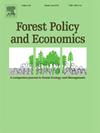Optimal forest management of Douglas-fir in Western Oregon: Stochastic prices, carbon sequestration and wildfire risk
IF 3.8
2区 农林科学
Q1 ECONOMICS
引用次数: 0
Abstract
Douglas-fir (Pseudotsuga menziesii) forests in Western Oregon provide economic and ecological benefits but increasing wildfire risks and timber price fluctuations challenge sustainable management. This study applies reservation price model to assess how these uncertainties affect optimal harvest timing and economic returns in even-aged Douglas-fir plantations. Results indicate that wildfire risk reduces reservation prices by up to 15 %, prompting earlier harvests to minimize losses. Under high wildfire risk (λ = 0.04), optimal harvest age decreases from 65.2 years to approximately 24 years, while land values decline by 50 %, from $14,104/ha to $6414/ha. This decline is steeper than previous estimates, where land values declined between 28.7 % and 41.2 % under wildfire risk scenarios. The larger reduction in this study suggests higher fire arrival rates and salvageable timber may amplify wildfire-induced economic losses. Underage-dependent wildfire risk, land values also decline, from $14,104/ha to $8297.5/ha at λ = 0.04, with mean harvest age decreasing from 65.2 to 33.2 years. Increasing salvageable portions from 30 % to 70 % elevates reservation prices by 5–9 %, mitigating losses. At a carbon price of $35/tCO₂e, optimal rotation age reaches 65.2 years in the absence of wildfire risk. However, it drops to 24.0 years under high constant risk and to 32.4 years under high age-dependent risk, indicating that wildfire risk offsets the rotation-lengthening effect of carbon pricing. These findings underscore the need for adaptive management strategies that integrate wildfire risk and market uncertainty. Policy recommendations include enhanced carbon pricing, improved salvage incentives, and risk-adjusted forest management strategies to sustain long-term economic viability.
俄勒冈西部道格拉斯冷杉的最佳森林管理:随机价格、碳固存和野火风险
俄勒冈州西部的道格拉斯冷杉林提供了经济和生态效益,但不断增加的野火风险和木材价格波动对可持续管理构成挑战。本研究运用保留价格模型来评估这些不确定性如何影响均匀树龄道格拉斯杉木人工林的最佳采收时机和经济回报。结果表明,野火风险使保留区价格降低了15%,促使提前收获以尽量减少损失。在高野火风险(λ = 0.04)下,最佳采收年龄从65.2年下降到约24年,而土地价值下降50%,从$14,104/ha下降到$6414/ha。这一下降幅度比之前的估计要大,在野火风险情景下,土地价值下降了28.7%至41.2%。本研究中较大的减少表明,较高的火灾到达率和可回收木材可能会扩大野火造成的经济损失。在λ = 0.04时,土地价值也从14104美元/公顷下降到8297.5美元/公顷,平均收获年龄从65.2年下降到33.2年。将可回收部分从30%提高到70%,保留价格提高了5 - 9%,减少了损失。当碳价格为35美元/tCO₂e时,在不存在野火风险的情况下,最佳轮作年龄为65.2年。然而,在高恒定风险和高年龄依赖风险下,野火风险降低到24.0年和32.4年,表明野火风险抵消了碳定价的旋转延长效应。这些发现强调了整合野火风险和市场不确定性的适应性管理策略的必要性。政策建议包括提高碳定价、改进救助激励措施和调整风险的森林管理战略,以维持长期经济可行性。
本文章由计算机程序翻译,如有差异,请以英文原文为准。
求助全文
约1分钟内获得全文
求助全文
来源期刊

Forest Policy and Economics
农林科学-林学
CiteScore
9.00
自引率
7.50%
发文量
148
审稿时长
21.9 weeks
期刊介绍:
Forest Policy and Economics is a leading scientific journal that publishes peer-reviewed policy and economics research relating to forests, forested landscapes, forest-related industries, and other forest-relevant land uses. It also welcomes contributions from other social sciences and humanities perspectives that make clear theoretical, conceptual and methodological contributions to the existing state-of-the-art literature on forests and related land use systems. These disciplines include, but are not limited to, sociology, anthropology, human geography, history, jurisprudence, planning, development studies, and psychology research on forests. Forest Policy and Economics is global in scope and publishes multiple article types of high scientific standard. Acceptance for publication is subject to a double-blind peer-review process.
 求助内容:
求助内容: 应助结果提醒方式:
应助结果提醒方式:


